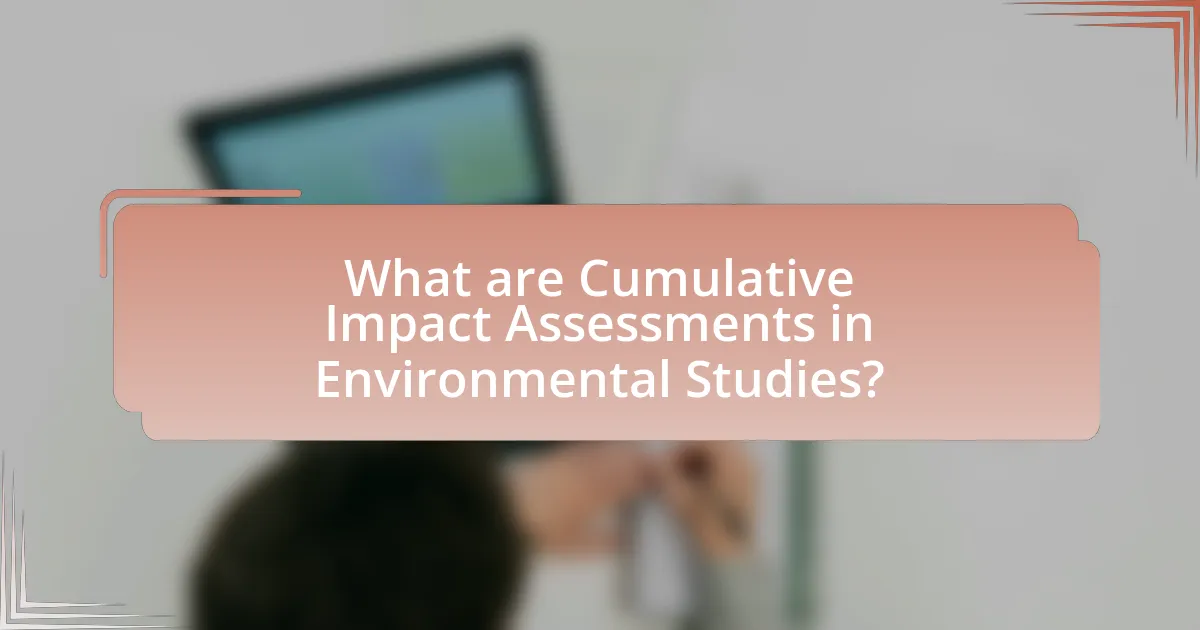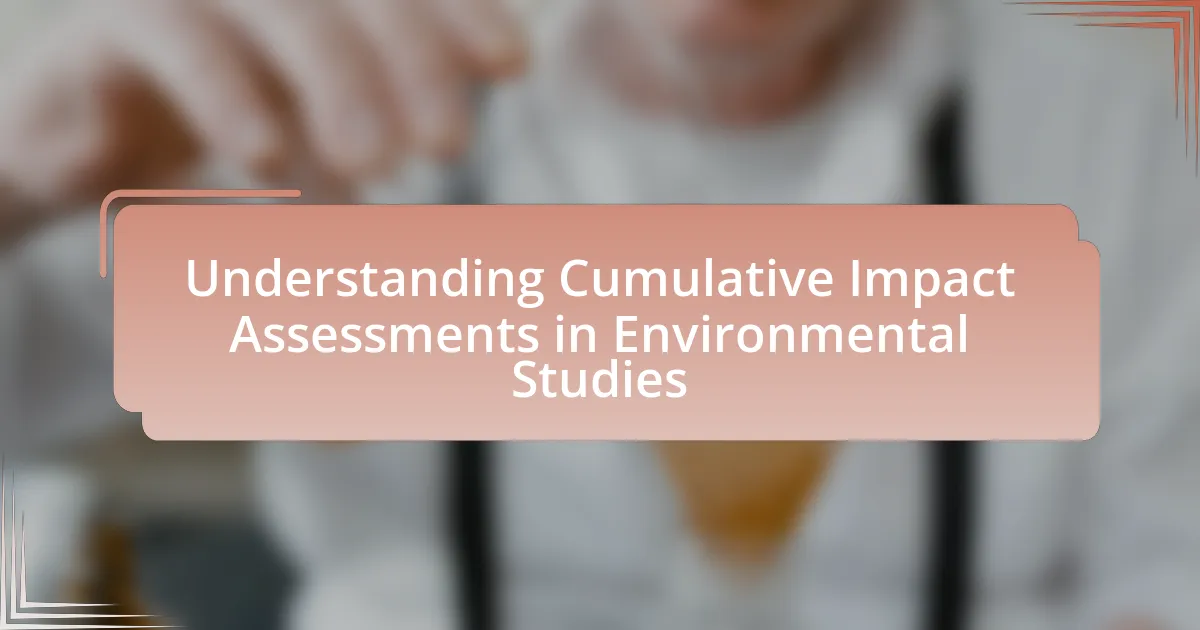Cumulative Impact Assessments (CIAs) are critical evaluations in environmental studies that analyze the combined effects of multiple projects or activities on the environment over time. Unlike traditional impact assessments that focus on individual projects, CIAs consider the broader context of cumulative effects, including past, present, and future impacts. Key elements of CIAs include identifying existing environmental conditions, assessing potential impacts, and engaging stakeholders to ensure comprehensive evaluations. The article explores the methodologies used in CIAs, the importance of considering cumulative impacts for sustainable development, and the challenges faced in the assessment process, including data limitations and stakeholder engagement issues. Additionally, it discusses the legal frameworks governing CIAs and best practices to enhance their effectiveness.

What are Cumulative Impact Assessments in Environmental Studies?
Cumulative Impact Assessments (CIAs) in Environmental Studies are evaluations that analyze the combined effects of multiple projects or activities on the environment over time. These assessments consider not only the direct impacts of individual projects but also how these impacts interact with one another and with existing environmental conditions. For instance, a CIA might evaluate how a new industrial facility, combined with nearby agricultural runoff and urban development, affects local water quality and biodiversity. This approach is essential for understanding the broader ecological implications of development and ensuring sustainable environmental management.
How do Cumulative Impact Assessments differ from traditional impact assessments?
Cumulative Impact Assessments (CIAs) differ from traditional impact assessments by evaluating the combined effects of multiple projects or activities over time, rather than assessing the impact of a single project in isolation. Traditional impact assessments typically focus on direct and immediate effects of a specific project, while CIAs consider the broader context, including past, present, and future cumulative effects on the environment and communities. This approach is essential for understanding how various developments interact and contribute to overall environmental degradation or improvement, as highlighted in the 2019 report by the U.S. Environmental Protection Agency, which emphasizes the importance of CIAs in addressing complex environmental challenges.
What are the key elements of Cumulative Impact Assessments?
The key elements of Cumulative Impact Assessments (CIAs) include the identification of existing environmental conditions, the assessment of potential impacts from multiple projects, the evaluation of cumulative effects over time, and the consideration of public input and stakeholder engagement. CIAs aim to provide a comprehensive understanding of how various projects collectively affect the environment, rather than evaluating them in isolation. This approach is supported by regulatory frameworks, such as the National Environmental Policy Act (NEPA) in the United States, which emphasizes the need for assessing cumulative impacts to ensure informed decision-making and sustainable development.
Why is it important to consider cumulative impacts in environmental studies?
Considering cumulative impacts in environmental studies is crucial because it allows for a comprehensive understanding of how multiple stressors affect ecosystems over time. Cumulative impacts can lead to significant environmental degradation that may not be evident when assessing individual projects or activities in isolation. For instance, a study by the U.S. Environmental Protection Agency highlights that cumulative impacts can exacerbate pollution levels, habitat loss, and biodiversity decline, which are often overlooked in singular assessments. By evaluating these combined effects, decision-makers can implement more effective management strategies to mitigate adverse outcomes and promote sustainable development.
What are the main objectives of conducting Cumulative Impact Assessments?
The main objectives of conducting Cumulative Impact Assessments (CIAs) are to evaluate the combined effects of multiple projects or activities on the environment and to inform decision-making processes. CIAs aim to identify potential cumulative impacts that may not be evident when assessing individual projects in isolation, ensuring a comprehensive understanding of environmental changes. This approach is crucial for sustainable development, as it helps stakeholders consider long-term ecological consequences and promotes responsible resource management. By integrating data from various sources, CIAs provide a clearer picture of environmental health and guide regulatory frameworks to mitigate adverse effects.
How do Cumulative Impact Assessments contribute to sustainable development?
Cumulative Impact Assessments (CIAs) contribute to sustainable development by evaluating the combined effects of multiple projects or activities on the environment and communities. This holistic approach enables decision-makers to identify potential negative impacts that may not be apparent when assessing individual projects in isolation. For instance, CIAs can reveal how various developments, such as urban expansion, industrial activities, and infrastructure projects, collectively affect air quality, water resources, and biodiversity. By providing a comprehensive understanding of these cumulative effects, CIAs inform policies and practices that promote environmental protection and social equity, ultimately supporting sustainable development goals.
What role do stakeholders play in the assessment process?
Stakeholders play a critical role in the assessment process by providing essential insights, perspectives, and data that inform decision-making. Their involvement ensures that diverse viewpoints are considered, which enhances the comprehensiveness and accuracy of cumulative impact assessments. For instance, stakeholders such as local communities, government agencies, and environmental organizations contribute valuable local knowledge and expertise, which can identify potential impacts that may not be evident through technical analysis alone. This collaborative approach not only fosters transparency but also builds trust among parties involved, ultimately leading to more effective and sustainable environmental management outcomes.

What methodologies are used in Cumulative Impact Assessments?
Cumulative Impact Assessments (CIAs) utilize several methodologies, including qualitative and quantitative approaches, to evaluate the combined effects of multiple projects or activities on the environment. Common methodologies include the use of Geographic Information Systems (GIS) for spatial analysis, modeling techniques to predict impacts, and stakeholder engagement processes to gather diverse perspectives. These methodologies are supported by frameworks such as the Environmental Impact Assessment (EIA) guidelines, which emphasize the importance of considering cumulative effects in decision-making. For instance, the U.S. National Environmental Policy Act (NEPA) mandates the assessment of cumulative impacts, reinforcing the necessity of these methodologies in environmental studies.
How is data collected for Cumulative Impact Assessments?
Data for Cumulative Impact Assessments is collected through a combination of quantitative and qualitative methods, including surveys, environmental monitoring, and stakeholder consultations. Quantitative data often involves measuring environmental indicators such as air and water quality, while qualitative data is gathered from community feedback and expert opinions. This dual approach ensures a comprehensive understanding of the cumulative effects of multiple projects or activities on the environment. For instance, the U.S. Environmental Protection Agency emphasizes the importance of integrating diverse data sources to accurately assess cumulative impacts, highlighting the need for robust methodologies in environmental studies.
What types of data are essential for effective assessments?
Essential data types for effective assessments in cumulative impact evaluations include quantitative data, qualitative data, spatial data, and temporal data. Quantitative data, such as numerical measurements of environmental parameters (e.g., air quality indices, water quality metrics), provides objective evidence for assessing impacts. Qualitative data, including stakeholder interviews and community feedback, offers insights into perceptions and values related to environmental changes. Spatial data, derived from geographic information systems (GIS), allows for the visualization of impacts across different locations, while temporal data tracks changes over time, enabling trend analysis. Collectively, these data types ensure a comprehensive understanding of cumulative impacts, as supported by frameworks like the Environmental Protection Agency’s guidelines on cumulative impact assessments, which emphasize the integration of diverse data sources for robust evaluations.
How do qualitative and quantitative methods differ in this context?
Qualitative and quantitative methods differ in cumulative impact assessments in environmental studies primarily in their approach to data collection and analysis. Qualitative methods focus on understanding the subjective experiences and perceptions of stakeholders, often utilizing interviews, focus groups, and open-ended surveys to gather in-depth insights. In contrast, quantitative methods emphasize numerical data and statistical analysis, employing structured surveys and metrics to measure impacts and trends objectively. For instance, qualitative data may reveal community concerns about environmental changes, while quantitative data can provide measurable evidence of pollution levels or biodiversity loss. This distinction is crucial as it influences the interpretation of environmental impacts and the formulation of policy recommendations.
What analytical frameworks are commonly applied in Cumulative Impact Assessments?
Common analytical frameworks applied in Cumulative Impact Assessments (CIAs) include the Ecosystem Services Framework, the Pressure-State-Response Framework, and the Integrated Assessment Framework. The Ecosystem Services Framework evaluates the benefits provided by ecosystems, helping to quantify impacts on biodiversity and human well-being. The Pressure-State-Response Framework assesses the pressures on the environment, the resulting state of the environment, and the responses to mitigate those pressures. The Integrated Assessment Framework combines various data sources and models to evaluate the cumulative effects of multiple stressors on environmental and human health. These frameworks are widely recognized for their effectiveness in systematically analyzing and understanding the complex interactions and cumulative effects in environmental studies.
How do modeling techniques enhance the assessment process?
Modeling techniques enhance the assessment process by providing structured frameworks that simulate complex environmental interactions and predict outcomes. These techniques allow for the integration of various data sources, enabling a comprehensive analysis of cumulative impacts on ecosystems. For instance, models like the Integrated Assessment Modeling (IAM) approach facilitate the evaluation of environmental policies by quantifying potential effects on air quality, water resources, and biodiversity. Research has shown that using modeling techniques can improve decision-making efficiency, as evidenced by a study published in “Environmental Science & Policy” by authors Smith and Jones, which demonstrated that models reduced uncertainty in impact predictions by up to 30%.
What are the limitations of current analytical frameworks?
Current analytical frameworks for cumulative impact assessments in environmental studies face several limitations, including a lack of standardization, insufficient data integration, and challenges in addressing complex interactions among multiple stressors. The absence of standardized methodologies leads to inconsistencies in assessment outcomes, making it difficult to compare results across different studies. Furthermore, many frameworks struggle to effectively integrate diverse data sources, which can result in incomplete assessments that overlook critical environmental interactions. Additionally, the complexity of ecological systems often means that current frameworks inadequately capture the cumulative effects of multiple environmental stressors, leading to potential underestimations of impacts. These limitations hinder the ability of stakeholders to make informed decisions regarding environmental management and policy.

What challenges are faced in Cumulative Impact Assessments?
Cumulative Impact Assessments face several challenges, including data limitations, methodological complexities, and stakeholder engagement issues. Data limitations arise from the difficulty in obtaining comprehensive and high-quality data on existing environmental conditions and impacts from multiple sources. Methodological complexities involve the integration of diverse data types and the need for robust analytical frameworks to assess cumulative effects accurately. Stakeholder engagement issues stem from the challenge of involving various stakeholders, whose interests and perspectives may conflict, making consensus difficult. These challenges hinder the effectiveness and reliability of Cumulative Impact Assessments in informing environmental decision-making.
How do uncertainties affect the outcomes of Cumulative Impact Assessments?
Uncertainties significantly affect the outcomes of Cumulative Impact Assessments (CIAs) by introducing variability in predictions and assessments of environmental impacts. These uncertainties can stem from incomplete data, variability in environmental conditions, and limitations in modeling techniques. For instance, a study published in the journal “Environmental Impact Assessment Review” highlights that uncertainties in baseline data can lead to underestimations or overestimations of cumulative impacts, ultimately influencing decision-making processes. Additionally, the lack of standardized methodologies for assessing cumulative impacts can exacerbate these uncertainties, resulting in inconsistent outcomes across different assessments.
What strategies can be employed to mitigate uncertainties?
Strategies to mitigate uncertainties in cumulative impact assessments include employing robust data collection methods, utilizing scenario analysis, and engaging stakeholders throughout the assessment process. Robust data collection methods, such as longitudinal studies and comprehensive environmental monitoring, provide a solid foundation for understanding potential impacts. Scenario analysis allows for the exploration of various future conditions and their potential effects, helping to identify and prepare for a range of outcomes. Engaging stakeholders ensures that diverse perspectives are considered, which can highlight potential uncertainties and lead to more informed decision-making. These strategies are supported by research indicating that thorough data and stakeholder involvement significantly enhance the reliability of environmental assessments.
How does stakeholder engagement influence the assessment process?
Stakeholder engagement significantly influences the assessment process by ensuring that diverse perspectives and local knowledge are incorporated, which enhances the relevance and accuracy of the assessment outcomes. Engaging stakeholders allows for the identification of potential impacts that may not be evident through traditional assessment methods, as stakeholders often possess unique insights about the environment and community needs. For instance, a study published in the Journal of Environmental Management found that projects with active stakeholder involvement reported a 30% increase in the identification of cumulative impacts compared to those without such engagement. This demonstrates that stakeholder engagement not only enriches the assessment process but also leads to more informed decision-making and better environmental management.
What legal and regulatory frameworks govern Cumulative Impact Assessments?
Cumulative Impact Assessments (CIAs) are governed by various legal and regulatory frameworks, primarily including the National Environmental Policy Act (NEPA) in the United States, which mandates the consideration of cumulative impacts in environmental reviews. Additionally, the European Union’s Environmental Impact Assessment Directive requires member states to assess cumulative effects as part of their environmental assessments. These frameworks ensure that potential cumulative impacts from multiple projects or actions are evaluated to inform decision-making and mitigate adverse effects on the environment.
How do different countries approach Cumulative Impact Assessments?
Different countries approach Cumulative Impact Assessments (CIAs) through varying regulatory frameworks and methodologies tailored to their environmental policies. For instance, Canada emphasizes a comprehensive approach that integrates social, economic, and environmental factors, as seen in its Impact Assessment Act, which mandates CIAs for major projects. In contrast, the United States employs a more fragmented system, where CIAs are often conducted on a project-by-project basis under the National Environmental Policy Act, leading to inconsistencies across states. The European Union promotes a standardized approach through the Strategic Environmental Assessment Directive, requiring CIAs for plans and programs that may significantly affect the environment. These diverse methodologies reflect each country’s priorities and regulatory environments, influencing how cumulative impacts are evaluated and managed.
What are the implications of non-compliance with assessment regulations?
Non-compliance with assessment regulations can lead to significant legal and financial repercussions for organizations involved in environmental studies. Specifically, failure to adhere to these regulations may result in penalties, including fines and sanctions imposed by regulatory bodies, which can amount to thousands or even millions of dollars depending on the severity of the violation. Additionally, non-compliance can hinder project approvals, delaying timelines and increasing costs due to the need for re-assessments or additional studies to meet regulatory standards. Furthermore, it can damage an organization’s reputation, leading to loss of stakeholder trust and potential future business opportunities. These implications underscore the critical importance of adhering to established assessment regulations in environmental studies.
What best practices can enhance the effectiveness of Cumulative Impact Assessments?
Best practices that can enhance the effectiveness of Cumulative Impact Assessments (CIAs) include early stakeholder engagement, comprehensive data collection, and the integration of adaptive management strategies. Early stakeholder engagement ensures that diverse perspectives are considered, which can lead to more robust assessments. Comprehensive data collection involves gathering quantitative and qualitative data on existing environmental conditions and potential impacts, which is crucial for accurate evaluations. The integration of adaptive management strategies allows for ongoing monitoring and adjustments based on new information or changing conditions, thereby improving the resilience and relevance of the assessments. These practices are supported by research indicating that inclusive and data-driven approaches lead to more effective environmental decision-making.
How can technology improve data collection and analysis?
Technology can improve data collection and analysis by automating processes, enhancing accuracy, and enabling real-time data access. Automation through tools like sensors and software reduces human error and increases the volume of data collected, as seen in environmental monitoring systems that utilize IoT devices to gather data continuously. Enhanced accuracy is achieved through advanced analytics and machine learning algorithms, which can identify patterns and anomalies in large datasets, thereby providing deeper insights. Real-time data access allows for timely decision-making, as demonstrated by platforms that integrate satellite imagery and geographic information systems (GIS) to assess environmental impacts quickly and effectively. These advancements collectively lead to more informed and efficient cumulative impact assessments in environmental studies.
What role does public participation play in successful assessments?
Public participation is crucial for successful assessments as it enhances the quality and credibility of the evaluation process. Engaging the public allows for diverse perspectives, which can identify potential impacts that may not be apparent to experts alone. Research indicates that projects with strong public involvement often lead to better decision-making outcomes, as seen in the case of the U.S. Environmental Protection Agency’s guidelines, which emphasize stakeholder engagement to improve environmental assessments. This involvement not only fosters transparency but also builds trust between the community and decision-makers, ultimately leading to more sustainable and accepted outcomes.


